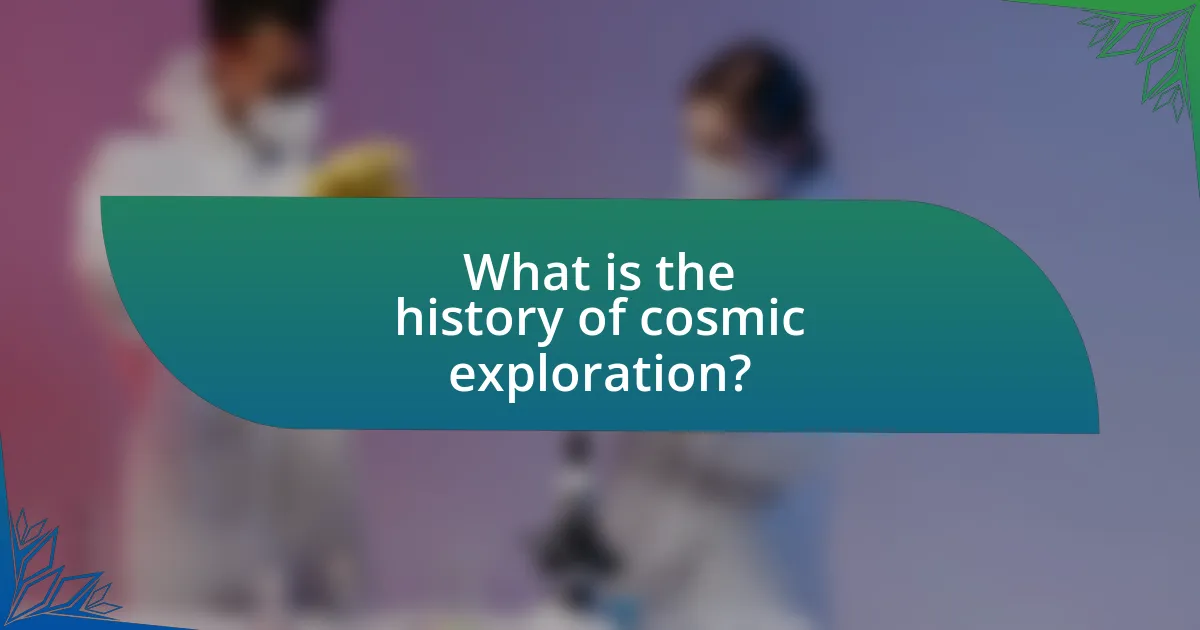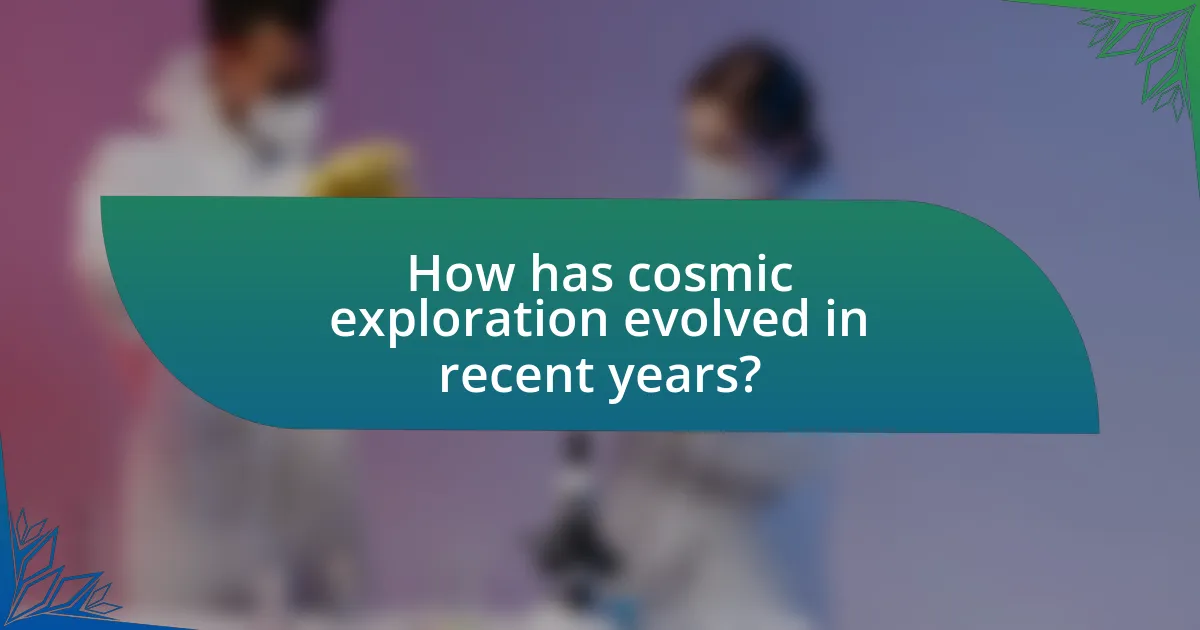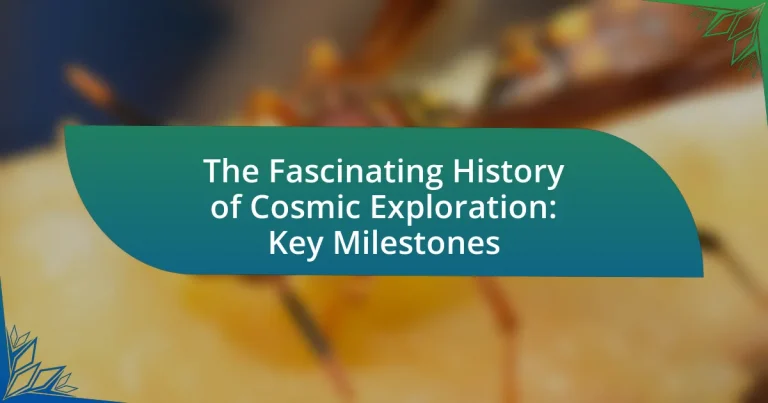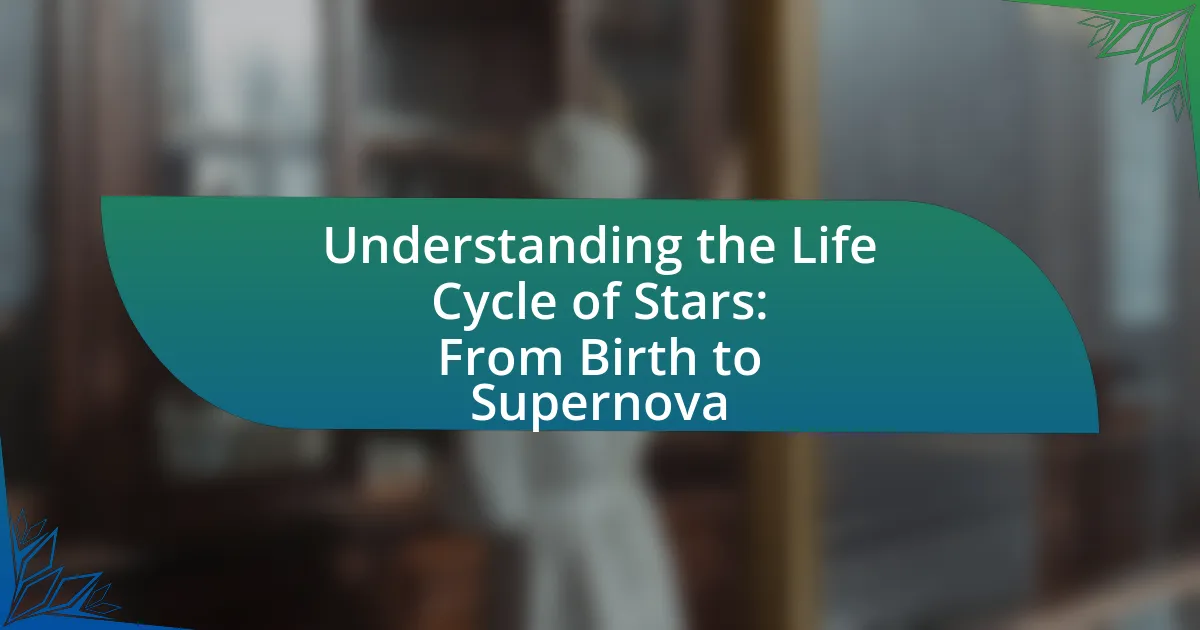The article explores the history of cosmic exploration, highlighting key milestones from early astronomical observations to modern space missions. It details significant events such as the launch of Sputnik 1, the Apollo 11 Moon landing, and the establishment of the International Space Station, illustrating the evolution of human understanding of the universe. The article also examines contributions from ancient civilizations, pivotal figures during the Renaissance, and the impact of robotic missions on space exploration. Additionally, it discusses current trends in space technology, the role of private companies, and ethical considerations surrounding future exploration and potential colonization of other planets.

What is the history of cosmic exploration?
The history of cosmic exploration began with early astronomical observations and has evolved into modern space missions. In the 20th century, significant milestones included the launch of Sputnik 1 by the Soviet Union in 1957, marking the first artificial satellite in orbit, and the subsequent space race between the United States and the Soviet Union. The U.S. Apollo program achieved a historic milestone when Apollo 11 landed humans on the Moon in 1969. Following these events, robotic missions such as Voyager 1 and 2, launched in 1977, provided invaluable data about the outer planets and beyond. The establishment of the International Space Station in 1998 further exemplified international collaboration in space exploration. Each of these events contributed to our understanding of the universe and paved the way for future exploration endeavors.
How did early civilizations contribute to our understanding of the cosmos?
Early civilizations significantly advanced our understanding of the cosmos through their astronomical observations and interpretations. The Babylonians, for instance, meticulously recorded celestial events, leading to the development of a lunar calendar and the prediction of eclipses, which demonstrated their ability to track celestial bodies. Similarly, the ancient Greeks, particularly figures like Ptolemy, formulated geocentric models that influenced astronomical thought for centuries. Their work laid the groundwork for later scientific inquiry by establishing a systematic approach to studying the heavens. Additionally, the Mayans created complex calendars based on their observations of planetary movements, showcasing their advanced understanding of celestial cycles. These contributions collectively shaped the foundational knowledge of astronomy, influencing subsequent civilizations and scientific advancements.
What astronomical observations were made by ancient cultures?
Ancient cultures made significant astronomical observations, including the tracking of celestial bodies, the identification of constellations, and the recording of lunar phases. For instance, the Babylonians meticulously documented planetary movements and developed early forms of astrology around 2000 BCE, while the Mayans created complex calendars based on their observations of the sun, moon, and planets, notably the Venus cycle. Additionally, the Egyptians aligned their pyramids with the stars, demonstrating their understanding of celestial navigation. These observations laid the groundwork for modern astronomy and reflect the advanced knowledge of ancient civilizations regarding the cosmos.
How did mythology influence early astronomical thought?
Mythology significantly influenced early astronomical thought by providing a framework for understanding celestial phenomena through narratives and deities. Ancient civilizations, such as the Babylonians and Greeks, associated planets and stars with gods and mythological stories, which helped them interpret the movements of celestial bodies. For instance, the Greeks named planets after their gods, like Venus for Aphrodite and Mars for Ares, reflecting their cultural beliefs and values. This connection between mythology and astronomy facilitated the development of early calendars and navigation systems, as societies sought to align their agricultural and social activities with celestial events, such as solstices and equinoxes. The integration of mythological narratives into astronomical observations laid the groundwork for future scientific inquiry, as it encouraged systematic observation and record-keeping of celestial events.
What were the key developments in astronomy during the Renaissance?
The key developments in astronomy during the Renaissance included the heliocentric model proposed by Nicolaus Copernicus, the advancements in observational techniques by Galileo Galilei, and the formulation of laws of planetary motion by Johannes Kepler. Copernicus challenged the geocentric view, asserting that the Sun, rather than the Earth, is at the center of the universe, which laid the groundwork for modern astronomy. Galileo improved the telescope, allowing for detailed observations of celestial bodies, such as the moons of Jupiter and the phases of Venus, providing empirical support for the heliocentric theory. Kepler’s laws, derived from meticulous observations by Tycho Brahe, described the elliptical orbits of planets, fundamentally changing the understanding of planetary motion. These developments collectively marked a significant shift in astronomical thought and methodology during the Renaissance.
How did the invention of the telescope change our view of the universe?
The invention of the telescope fundamentally transformed our understanding of the universe by enabling astronomers to observe celestial bodies in unprecedented detail. This advancement allowed for the discovery of moons orbiting Jupiter, the phases of Venus, and the intricate structure of Saturn’s rings, as demonstrated by Galileo Galilei in the early 17th century. These observations challenged the geocentric model of the universe, leading to the acceptance of the heliocentric model proposed by Copernicus, which positioned the Sun at the center of our solar system. The telescope’s ability to reveal distant stars and galaxies further expanded our comprehension of the cosmos, establishing that the universe is vast and filled with countless celestial objects, fundamentally altering humanity’s place within it.
Who were the pivotal figures in Renaissance astronomy?
The pivotal figures in Renaissance astronomy include Nicolaus Copernicus, Johannes Kepler, and Galileo Galilei. Nicolaus Copernicus proposed the heliocentric model, which placed the Sun at the center of the universe, fundamentally changing the understanding of celestial mechanics. Johannes Kepler formulated the laws of planetary motion, demonstrating that planets move in elliptical orbits, which provided a mathematical foundation for Copernicus’s theories. Galileo Galilei made significant astronomical observations using a telescope, including the discovery of Jupiter’s moons and the phases of Venus, which supported the heliocentric model and challenged the prevailing geocentric view. These contributions collectively advanced the field of astronomy during the Renaissance, leading to a paradigm shift in scientific thought.

What are the major milestones in space exploration?
The major milestones in space exploration include the launch of Sputnik 1 in 1957, which marked the first artificial satellite in orbit, and the Apollo 11 mission in 1969, during which humans first landed on the Moon. Additionally, the launch of the Space Shuttle in 1981 enabled reusable spacecraft for various missions, while the Mars Rover missions, starting with Spirit and Opportunity in 2004, expanded our understanding of the Martian environment. The International Space Station, continuously inhabited since 2000, serves as a hub for international scientific research in low Earth orbit. Each of these milestones represents significant advancements in technology and human capability in exploring outer space.
What were the significant achievements of the Space Age?
The significant achievements of the Space Age include the launch of the first artificial satellite, Sputnik 1, by the Soviet Union in 1957, which marked the beginning of space exploration. This was followed by the first human in space, Yuri Gagarin, in 1961, demonstrating human capability for space travel. The Apollo 11 mission in 1969 achieved the first manned moon landing, with astronauts Neil Armstrong and Buzz Aldrin walking on the lunar surface, a pivotal moment in human history. Additionally, the development of space stations, such as the International Space Station, has facilitated long-term human presence in space and international collaboration in scientific research. These milestones collectively advanced our understanding of space and technology, showcasing human ingenuity and ambition.
How did the launch of Sputnik impact global politics and science?
The launch of Sputnik on October 4, 1957, significantly impacted global politics and science by intensifying the Cold War rivalry between the United States and the Soviet Union. This event marked the beginning of the space race, prompting the U.S. to accelerate its own space exploration efforts, leading to the establishment of NASA in 1958. The successful deployment of Sputnik demonstrated Soviet technological prowess, which caused alarm in the U.S. and led to increased military and scientific investments. Furthermore, Sputnik’s launch initiated a new era of scientific research in space, influencing international collaborations and advancements in satellite technology, telecommunications, and Earth observation. The geopolitical implications were profound, as nations recognized the strategic importance of space capabilities, reshaping defense policies and international relations.
What were the milestones of human spaceflight?
The milestones of human spaceflight include significant events that marked advancements in space exploration. The first milestone was Yuri Gagarin’s historic flight on April 12, 1961, making him the first human to orbit Earth aboard Vostok 1. Following this, the United States achieved its first crewed spaceflight with Alan Shepard’s suborbital flight on May 5, 1961, in Freedom 7. The Apollo 11 mission on July 20, 1969, became a landmark event as Neil Armstrong and Buzz Aldrin became the first humans to walk on the Moon. Another key milestone was the launch of the Space Shuttle program in 1981, which enabled reusable spacecraft for various missions. The International Space Station (ISS), launched in 1998, represents a significant collaborative effort in human spaceflight, serving as a microgravity research laboratory. Each of these milestones has contributed to the evolution of human capabilities in space exploration.
What role did robotic missions play in cosmic exploration?
Robotic missions have been crucial in cosmic exploration by enabling the collection of data from environments that are too hostile or distant for human presence. These missions, such as the Voyager spacecraft, have provided invaluable insights into the outer planets and their moons, revealing details about their atmospheres, surfaces, and potential for life. For instance, Voyager 1 and 2, launched in 1977, have traveled beyond the solar system, sending back data that has expanded our understanding of interstellar space. Additionally, robotic landers and rovers, like Mars Curiosity and Perseverance, have conducted in-situ analysis of Martian soil and atmosphere, contributing to the search for past life on Mars. These missions demonstrate the effectiveness of robotic technology in exploring and understanding the cosmos, often at a fraction of the cost and risk associated with human missions.
Which missions provided groundbreaking discoveries about other planets?
The missions that provided groundbreaking discoveries about other planets include NASA’s Voyager 1 and 2, which revealed detailed information about the outer planets and their moons, and the Mars rovers, such as Curiosity and Perseverance, which have uncovered evidence of past water and potential habitability on Mars. Voyager 1 and 2, launched in 1977, provided the first close-up images of Jupiter, Saturn, Uranus, and Neptune, significantly enhancing our understanding of these gas giants and their atmospheres. The Mars rovers, particularly Curiosity, which landed in 2012, discovered complex organic molecules and varied geological features, indicating that Mars once had conditions suitable for life.
How have telescopes expanded our understanding of the universe?
Telescopes have significantly expanded our understanding of the universe by enabling detailed observation of celestial objects and phenomena. The invention of the refracting telescope by Galileo in the early 17th century allowed for the discovery of Jupiter’s moons, which provided evidence against the geocentric model of the universe. Subsequent advancements, such as the development of the Hubble Space Telescope, have revealed the existence of distant galaxies, the expansion of the universe, and the presence of exoplanets. These observations have led to critical insights into the nature of dark matter and dark energy, fundamentally altering our comprehension of cosmic structure and evolution.

How has cosmic exploration evolved in recent years?
Cosmic exploration has significantly evolved in recent years through advancements in technology, increased international collaboration, and the emergence of private space companies. Notably, NASA’s Artemis program aims to return humans to the Moon by 2024, while SpaceX’s Crew Dragon successfully transported astronauts to the International Space Station in 2020, marking a new era of commercial spaceflight. Additionally, the Mars Perseverance rover, which landed on Mars in February 2021, is equipped with advanced scientific instruments to search for signs of ancient life and collect samples for future return to Earth. These developments illustrate a shift towards more ambitious and collaborative efforts in exploring outer space.
What are the current trends in space exploration technology?
Current trends in space exploration technology include the development of reusable launch systems, advancements in propulsion technologies, and increased collaboration between government and private sectors. Reusable launch systems, exemplified by SpaceX’s Falcon 9, significantly reduce costs and increase launch frequency. Advancements in propulsion, such as ion thrusters and nuclear thermal propulsion, enhance efficiency for deep space missions. Furthermore, partnerships like NASA’s Artemis program with commercial companies aim to return humans to the Moon and eventually reach Mars, reflecting a shift towards collaborative exploration efforts. These trends are supported by data showing a growing number of private space missions and investments in space technology, indicating a robust future for space exploration.
How are private companies influencing the future of space travel?
Private companies are significantly influencing the future of space travel by driving innovation, reducing costs, and increasing access to space. Companies like SpaceX and Blue Origin have developed reusable rocket technology, which has lowered launch costs by up to 30% compared to traditional methods. Additionally, private firms are expanding the market for satellite launches and space tourism, exemplified by SpaceX’s Crew Dragon missions and Blue Origin’s suborbital flights. These advancements not only enhance competition but also encourage government agencies to collaborate with private entities, as seen in NASA’s Commercial Crew Program, which aims to transport astronauts to the International Space Station using private spacecraft.
What advancements have been made in space telescopes and probes?
Recent advancements in space telescopes and probes include the launch of the James Webb Space Telescope (JWST), which has significantly enhanced our ability to observe distant galaxies and exoplanets with unprecedented clarity. The JWST, launched in December 2021, utilizes advanced infrared technology to penetrate cosmic dust and reveal previously hidden astronomical phenomena, allowing scientists to study the formation of stars and the chemical composition of distant worlds. Additionally, the European Space Agency’s Solar Orbiter, launched in February 2020, has provided groundbreaking data on solar winds and the Sun’s magnetic field, improving our understanding of solar activity and its effects on Earth. These advancements represent a leap forward in our capabilities for cosmic exploration, enabling deeper insights into the universe’s origins and dynamics.
What are the future prospects for cosmic exploration?
The future prospects for cosmic exploration include advancements in technology, increased international collaboration, and the potential for human settlement on other celestial bodies. Upcoming missions, such as NASA’s Artemis program aiming for lunar exploration and the European Space Agency’s Jupiter Icy Moons Explorer (JUICE), highlight a renewed focus on deep space. Additionally, private companies like SpaceX are developing reusable rocket technology, which could significantly reduce costs and increase access to space. These developments are supported by growing investments in space exploration, with global spending projected to reach over $1 trillion by 2040, indicating a robust future for cosmic exploration.
How might human colonization of other planets become a reality?
Human colonization of other planets might become a reality through advancements in space technology, sustainable life support systems, and international collaboration. Space agencies like NASA and private companies such as SpaceX are developing reusable rocket technology and spacecraft capable of long-duration missions, exemplified by SpaceX’s Starship, which aims to transport humans to Mars. Additionally, research into closed-loop life support systems, such as those being tested on the International Space Station, is crucial for sustaining human life in extraterrestrial environments. Historical milestones, such as the Apollo moon landings and the Mars rover missions, demonstrate humanity’s capability to explore and utilize other celestial bodies, laying the groundwork for future colonization efforts.
What are the ethical considerations of exploring and colonizing space?
The ethical considerations of exploring and colonizing space include the potential for environmental degradation, the rights of extraterrestrial life forms, and the implications of resource exploitation. Environmental degradation arises from the risk of contaminating celestial bodies, as evidenced by the Outer Space Treaty of 1967, which emphasizes the need to avoid harmful interference with space environments. The rights of extraterrestrial life forms are a concern, as the discovery of microbial life could challenge human-centric ethical frameworks, necessitating a reevaluation of our responsibilities towards non-Earth life. Additionally, resource exploitation raises questions about ownership and the equitable distribution of space resources, highlighted by the 1979 Moon Agreement, which aims to prevent the appropriation of celestial bodies. These considerations underscore the need for a robust ethical framework to guide humanity’s actions in space exploration and colonization.
What can we learn from the history of cosmic exploration?
The history of cosmic exploration teaches us about humanity’s quest for knowledge and the technological advancements that enable space travel. Key milestones, such as the launch of Sputnik in 1957, marked the beginning of the space age and demonstrated the potential for satellite technology. The Apollo 11 mission in 1969, which successfully landed humans on the Moon, showcased the capabilities of human ingenuity and international collaboration in science. Additionally, the development of the Hubble Space Telescope in 1990 expanded our understanding of the universe, revealing insights into the age and structure of galaxies. These events illustrate how cosmic exploration has driven scientific progress, fostered global cooperation, and inspired future generations to pursue careers in science and engineering.
How can past milestones inform future exploration strategies?
Past milestones in cosmic exploration can inform future exploration strategies by providing critical insights into successful methodologies, technological advancements, and the challenges faced during previous missions. For instance, the Apollo program’s achievements in the 1960s demonstrated the importance of rigorous testing and international collaboration, which can guide future missions to Mars and beyond. Historical data from missions like Voyager and Hubble have also highlighted the significance of long-term planning and adaptability in mission design, as these missions faced unforeseen challenges yet yielded groundbreaking discoveries. By analyzing these milestones, future strategies can be optimized to enhance mission success rates and scientific output.
What lessons have been learned about international cooperation in space?
International cooperation in space has demonstrated that collaborative efforts lead to enhanced scientific progress and resource sharing. The International Space Station (ISS), a joint project involving NASA, Roscosmos, ESA, JAXA, and CSA, exemplifies this, as it has facilitated over 20 years of continuous human presence in low Earth orbit, fostering international partnerships and shared research. Additionally, the success of the Mars rover missions, where multiple countries contributed technology and expertise, highlights the importance of pooling resources to achieve complex objectives. These examples underscore that collaboration not only accelerates technological advancements but also promotes peaceful relations among nations.
What are the best practices for engaging with the history of cosmic exploration?
The best practices for engaging with the history of cosmic exploration include studying primary sources, participating in educational programs, and utilizing interactive technologies. Primary sources, such as mission logs and astronaut interviews, provide firsthand accounts that enhance understanding of key milestones like the Apollo moon landings. Educational programs, including lectures and workshops, foster deeper insights into the scientific and cultural impacts of space exploration. Interactive technologies, such as virtual reality simulations of space missions, allow individuals to experience historical events in an immersive way, making the history more relatable and engaging. These practices collectively enrich the learning experience and promote a comprehensive understanding of cosmic exploration’s evolution.




